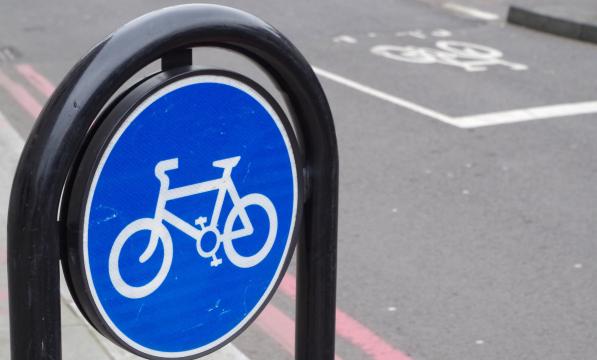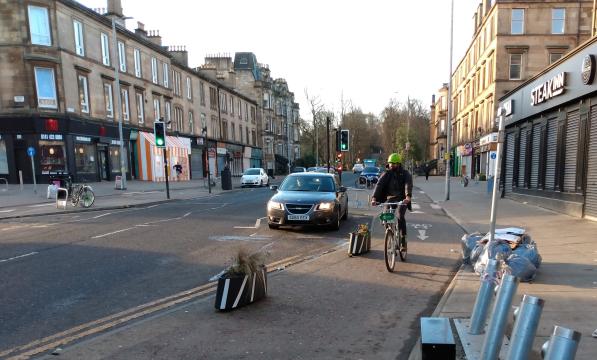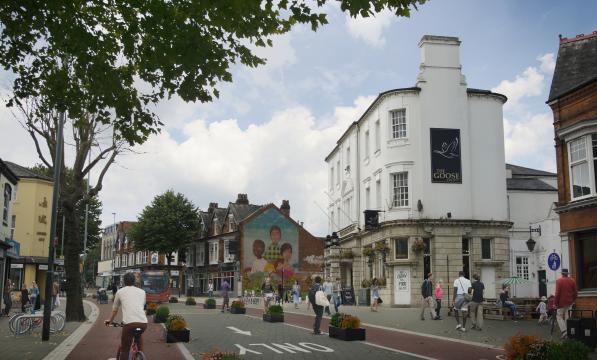Navigating road diversions by bike or on foot

What happens when a road is closed?
Cycling UK campaigner Zak Viney experienced a diversion in Sheffield recently. He shares how frustrating it can be that cyclists are directed along inappropriate and unsafe routes:
“I can track my commute by the second. But not today. I spot a sign: ‘Closed for maintenance. Cyclists and pedestrians please use the diversion.’
“An arrow points to the right. I take the turn. But where next? I scan the streetscape. There’s a sign! A small red fixture on the central reservation, telling me to go left. I go down the 25-metre corridor and feel a sense of dread as I hear the murmur of flowing motor traffic amplify and approach the next T-junction. I’ve driven along this A-road, it connects the city centre and the outer boroughs.
“I stick to the advisory cycle lane as cars and vans race by on the two lanes to my right. My heart races. There are vehicles parked in the cycle lane. I indicate right to pull out, look backwards – I hope that car slows up for me. I bargain with the driver, achieving eye contact, pleading with them to tolerate me. I pull out and negotiate the parked vehicle.
“This happens three or four more times. I’m still in one piece – but where am I? I pull over, struggle to remove my phone from my rucksack. I hammer in my workplace location, praying Google will act as my saviour. It informs me the right turn was 400 metres behind. Where was the sign? Did I do something wrong? I scurry to a pedestrian crossing to get across to other side of the highway.
“I stop three more times to check my location in the final mile, until I recognise the park which I use as my daily lunch spot. I pull into work, flustered but relieved and only 15 minutes late.”
All too familiar a tale
Have you experienced a morning like that? Whether that be the commute to work, cycling your children to school, or simply heading to your local shop.
Construction work is a necessity in order to make travel safer, faster and more comfortable. However, diversions for cyclists and pedestrians are often poorly signed and unsafe, and in some cases, not even considered at all.
Compare this with the treatment motorists receive. Projects are attended to urgently and financed significantly. They are turned over in quick stead with signage at every turn. It’s easy to see why many pedestrians and cyclists see a hierarchy of road users biased towards those driving.
A story from Belfast
The Lagan Towpath is one of the most popular active travel routes in Northern Ireland. Connecting Lisburn and Belfast, it sees thousands of journeys walked or cycled annually.
The route has recently been closed for six months, as the Department for Infrastructure (DfI) instals flood defences. However, a diversion that has been put in place for cyclists, routed along the Ormeau Embankment and into the city centre via the Ravenhill Road is considered unsafe and unfit – featuring a painted, advisory cycle lane often filled with parked cars.
Claire, an East Belfast resident, agrees: “The [Ravenhill] road is a complete and utter disaster for cycling. It’s unsafe, the painted cycle lane is used as a car park, there are often lorries unloading and doors opening. There are queues during rush hour with the associated fumes.
“The diversion is in place but it’s not as if there’s warning signs for motorists saying there might be increased cycle traffic during the diversion. Coming out of the city onto the Albert Bridge, you climb a hill and must cross four lanes of traffic to turn right, so it is difficult to go fast enough to feel safe.
“I am a confident cyclist but there is no way on earth I would let my kids cycle on that road. There is now no safe way for me to cycle to the city centre with them.”

Refurbished greenways, but no safe alternatives in Kirklees
The Birkby Bradley and Calder Valley Greenways have been closed for a prolonged period as Network Rail upgrades the Transpennine route. The alternative cycle route involves the busy Colne Bridge junctions and sharing space with heavy motor traffic on Leeds Road.
Chris Knight, a local campaigner from CycleKirklees, said: “We don’t have an issue with the works taking place, which are essential for the rail upgrade.
“These greenways are a lifeline for many cyclists in the area as there are no safe on-road cycle routes. For the next nine months people will need to use the only parallel route down the busy A62 which is 40 mph with painted cycle lanes and is currently going through reconstruction.
“A member of CycleKirklees has already been injured while attempting the signposted pedestrian diversion, down a narrow rough path. There are plans for the pedestrian diversion footpath to be upgraded by the council to a resurfaced shared use path. Proper planning would have meant those works were completed before this closure was put in place.”
The campaign group has launched a petition, calling for the local authority to provide a safe alternative route.

Legislation and guidelines
Andrew McClean, Cycling UK's engagement officer in Northern Ireland outlines the legislations and guidelines for cycle diversions:
It is likely, perhaps from experience, that you have very low expectations of cycle diversions meeting any sort of safety standard. Unsurprisingly, leaving provision largely to contractors’ own goodwill means it will always be at best an afterthought.
There is scant legislation to hold contractors to account, even under the Westminster 2015 Construction Regulations, which sets rules on how to maintain the safety of traffic routes during any works. The regulations fail to mention people cycling even once, only referring to pedestrians and vehicles, neither of which, according to their own definitions, include people cycling.
Wales, as with many aspects of active travel legislation, leads the way with a code of practice for ‘Safety at Street Works and Road Works’ which comes under the Welsh Active Travel Act. While local authorities still routinely fail to hold contractors to following this guidance, it does provide a solid framework for campaigners pushing for better provision.
What is notable about the guidance is the consistent prioritisation of ‘pedestrians and cyclists’ throughout, including the often forgotten ‘people using adapted cycles as mobility aids’.
More generally, Sustrans has set out very clear guidance on temporary diversions of national cycle network routes which points out that provision for any diversions should be in accordance with current cycle design standards, such as LTN 1/20, the Wales Active Travel Act Design Guide, and in Scotland, Cycling by Design.
However, given these are standards that are often not reached by permanent cycle infrastructure, it is very difficult to believe contractors are going to read them, let alone use them as a guide for their diverted routes.
Minimum expectations for cycle diversions
- Diversions should only be put in place where it is not possible to create space for people walking and cycling to continue using a safe route
- Risk assessment of the new route is completed, including consultation with users and representative bodies
- Informing local media and representative groups of the closure and diversion path
- The level of provision should be judged against the route it replaces, for example if it is replacing a traffic-free route then the safety, hazards and user experience should be of the same level on the diversion
- The route must be test cycled at various times of the day to identify hazards
- Adequate signage for directions at every junction and every 500m on longer stretches
- Signage at the start of any open section of the route to help cyclists avoid having to turn back once they meet the diversion
- Signage warning drivers of increased number of cyclists – reminding them to give space and be patient
- Increased traffic warden and visible police presence along the route for the duration of the diversion
- Temporary protection barriers on stretches where people cycling share space with cars with speed limits above 30mph
- There should be no requirement for people cycling to dismount throughout the diversion route
- Creation of temporary bus lanes where there are dual carriageways along the diversion route
Using the diversion as an opportunity
A core reason why cycle diversions are so poor is that few connected networks of safe, well-designed cycle infrastructure exist in the first instance. Currently, any changes or updates to highways should involve improvement for the provision of active travel. Diversion routes also offer an opportunity to trial the impact of a new cycle lane.
Planning for major works which involve diversions should always reference any plans for new cycle lanes. The chance to install a experimental or ‘pop-up’ cycle lane along the new route should always be considered as an option. This will help build awareness of cycling as an alternative transport choice, and following the trial and consultation, offer the opportunity to expand the safe cycle network within the area.







